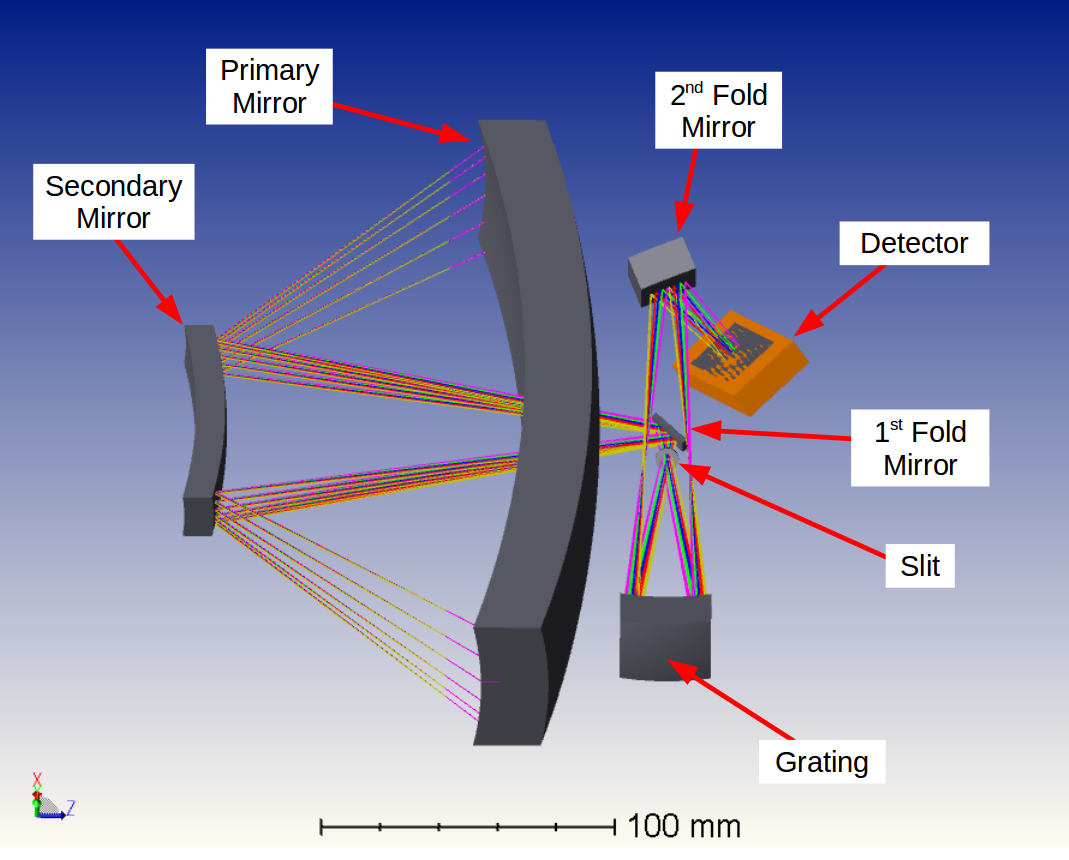Mission Design
About CubeSats
CubeSats are small satellites that are usually designed to perform scientific measurements and observations in space. The original specifications for CubeSats were released in 1999 by Cal Poly and Stanford University in an effort to standardize design to allow for reduced cost and increased accessibility to space. They come in multiples of a standard cube size of 10 cm x 10 cm x 10 cm, called units (U). They are launched as a “guest”, or a rideshare on a host rocket carrying much larger spacecraft. CUTE is a rideshare with the NASA/GSFC Landsat 9 mission, launching on an Atlas V near the end of September 2021.

Fig. 1: Ray trace of CUTE telescope.
About CUTE
CUTE is a 6U CubeSat whose bus and primary subsystems (including the attitude control system, GPS receiver, communication systems, electrical power system, and solar array) are provided by Blue Canyon Technologies.
CUTE contains a novel rectangular reflector that increases collection area by a factor of 3 over a standard circular aperture. It was designed by Co-I Brian Fleming and will be fabricated by Nu-Tek. With the exception of the grating, all mirrors will be coated in aluminum (Al) with a protective overcoat of magnesium fluoride over (MgF2). MgF2 helps prevent the formation of an oxide layer that can absorb UV light.
Here’s how light travels through the CUTE instrument, as shown in Fig. 1
- Light travels in from the left and is collected by a 20 cm x 8.5 cm rectangular Cassegrain telescope. The rectangular design provides more than three times the collecting area of conventional circular apertures that fit into a 1 U tall spacecraft.
- The incident beam is reflected off a small fold mirror (1st Fold Mirror) and passes through the spectrograph entrance slit, which has a projection of 23 arcminutes (23′) on the sky.
- Light is dispersed by an ion-etched diffraction grating (from Horiba J-Y) that builds off the heritage of the Cosmic Origins Spectrograph on the Hubble Space Telescope.
- The dispersed beam is then reflected off of a second fold mirror (2nd Fold Mirror) before being recorded on a UV-optimized 2048 x 515 pixel e2v CCD array (Detector).
The spacecraft bus is provided by Blue Canypn Technologies (BCT). The XB1 bus has 4U reserved for the CUTE science instrument with the remaining 2U containing the avionics, radios, batteries, reaction wheels, instrument electronics, and everything neeeded to keep CUTE operating while in orbit.
For more information about the optical design, see the Instrument Design section. For more information on the instrument and spacecraft integration and testing, see the Integration and Testing section.
Observing Strategy
CUTE will be in a nearly sun-synchronous orbit with a ~90 minute orbital period. During the one year nominal mission, CUTE will point at 10 known hot Jupiters and observe more than 10 transits per each. The resulting lightcurves will inform the CUTE team and the exoplanet community at large about the shape, size, and composition of these exoplanetary systems. Data will be hosted by the NASA Exoplanet Archive and available to the public roughly six months after observation.
